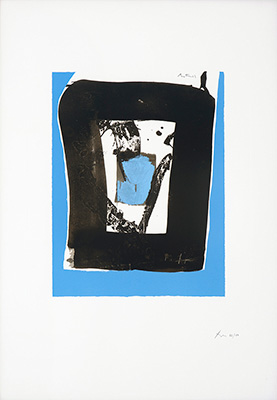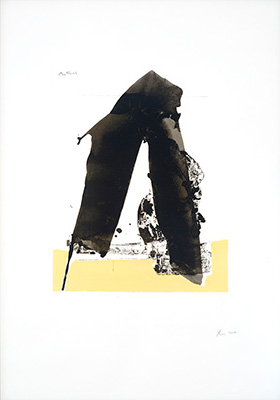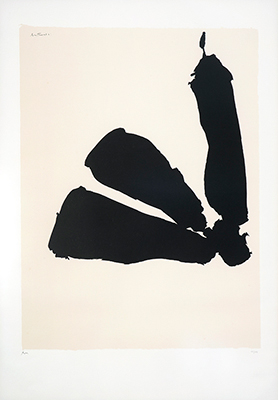(1915-1991)
Currently not on display

Robert Motherwell, Untitled, from the Basque suite (82/150), 1971. © Dedalus Foundation / SODRAC Montreal / VAGA, New York (2018). Photograph by the University of Regina.

Robert Motherwell, Untitled, from the Basque suite (139/150), 1971. © Dedalus Foundation / SODRAC Montreal / VAGA, New York (2018). Photograph by the University of Regina.

Robert Motherwell, Africa 8, from the Africa suite (141/150), 1970. © Dedalus Foundation / SODRAC Montreal / VAGA, New York (2018). Photograph by the University of Regina.
(top) Untitled, from the Basque suite (82/150), 1971
Screenprint on J.B. Green paper
39 1/2″ x 27 1/2″
University of Regina President’s Art Collection; pc.1975.11
(middle) Untitled, from the Basque suite (139/150), 1971
Screenprint on J.B. Green paper
39 1/2″ x 27 1/2″
University of Regina President’s Art Collection; pc.1975.10
(bottom) Africa 8, from the Africa suite (141/150), 1970
Screenprint on J.B. Green paper
39 1/2″ x 27 1/2″
University of Regina President’s Art Collection; pc.1975.9
Known for his large Abstract Expressionist canvases, Robert Motherwell’s prints offer a glimpse into another significant part of his overall oeuvre. Such was his interest that he became a printmaker skilled in numerous techniques, including making his own paper. He developed his techniques during the 1940’s at New York’s Atelier 17, a workshop that became a hub for recent immigrants and American artists alike. In addition to Motherwell, Louise Bourgeois, Marc Chagall, Max Ernst, Jackson Pollock and Mark Rothko could also be found engaging in the experimental and collaborative atmosphere the studio was known for. Unlike his Expressionist contemporaries for whom artmaking was a solitary and immediate enterprise, Motherwell was energised by collaborative – and more time consuming – printmaking projects. A more productive and significant period of printmaking was to follow in the 1960’s, when he began working with master printmaker, Irwin Hollander. Motherwell created the base images for the two works from the Basque suite in Hollander’s workshop in 1967.
New York’s Marlborough Gallery officially began to represent Motherwell as his primary dealer in 1970. Comprised of ten black-and-cream screenprints, the Africa suite was published by Marlborough Graphics; the first collaboration between Motherwell and this division of the gallery. Africa were automatic drawings utilizing large brushes, then “reworked with white acrylic overpainting and white paper masking to achieve the silhouettes of the final screenprints.”[1] The Africa theme was revisited several times in painting form. Naturally, Marlborough was the first to exhibit this series of work, alongside the original drawings in 1970.
These screenprints represent an early period of Motherwell’s printmaking oeuvre, and his first projects to use this technique. Around this time, he declared that etching and lithography were favourable over the “clumsiness” of screenprinting [2], although he still produced screenprints. These preferred processes offered more nuanced images with a greater sense of immediacy to satisfy these vital facets of his practice. All the prints in the University’s collection were purchased by the University of Regina in 1975 from Marlborough Godard Gallery, Toronto. Motherwell would continue producing prints up until his death in 1991.
Of the two works from the Basque suite, his catalogue raisonné states: “The title of this suite refers to the singular characteristics of the Basque language spoken in northeastern Spain, which employs Roman letters for its alphabet and is polysynthetic and agglutinative.”[3]
1 Engberg, Siri. Robert Motherwell: The Complete Prints 1940-1991: A Catalogue Raisonné. Walker Art Centre, Minneapolis; Hudson Mills, 2003: 105
2 ibid., p.25
3 ibid., p.110


